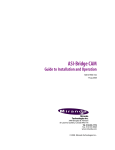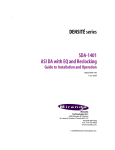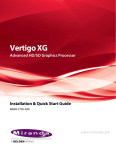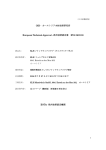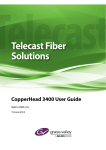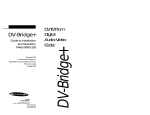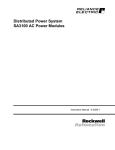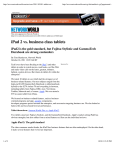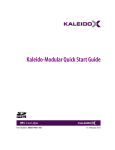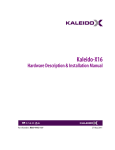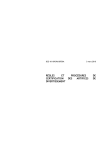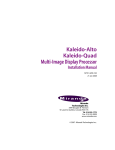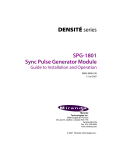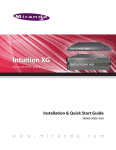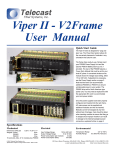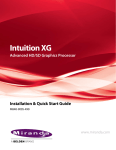Download CopperHead PowerWafer User Guide
Transcript
CopperHead PowerWafer User Guide M4002-9900-102 21 March 2014 Notices Copyright & Trademark Notice Copyright © 2014, Miranda Technologies Partnership. All rights reserved. Belden, Belden Sending All The Right Signals, and the Belden logo are trademarks or registered trademarks of Belden Inc. or its affiliated companies in the United States and other jurisdictions. Miranda, CopperHead PowerWafer are trademarks or registered trademarks of Miranda Technologies Partnership. Belden Inc., Miranda Technologies Partnership, and other parties may also have trademark rights in other terms used herein. Terms and Conditions Please read the following terms and conditions carefully. By using CopperHead PowerWafer documentation, you agree to the following terms and conditions. Miranda Technologies Partnership (“Miranda”) hereby grants permission and license to owners of CopperHead PowerWafer to use their product manuals for their own internal business use. Manuals for Miranda products may not be reproduced or transmitted in any form or by any means, electronic or mechanical, including photocopying and recording, for any purpose unless specifically authorized in writing by Miranda. A Miranda manual may have been revised to reflect changes made to the product during its manufacturing life. Thus, different versions of a manual may exist for any given product. Care should be taken to ensure that one obtains the proper manual version for a specific product serial number. Information in this document is subject to change without notice and does not represent a commitment on the part of Miranda. Warranty information is available in the Support section of the Miranda Web site (www.miranda.com). ii Title CopperHead PowerWafer User Guide Part Number M4002-9900-102 Revision 21 March 2014 Table of Contents 1 About CopperHead PowerWafer. . . . . . . . . . . . . . . . . . . . . . . . . 1 About CopperHead PowerWafer . . . . . . . . . . . . . . . . . . . . . . . . . . . . . . . . . . . . . . . . . . . . . . . . . . . 2 CopperHead System Features. . . . . . . . . . . . . . . . . . . . . . . . . . . . . . . . . . . . . . . . . . . . . . . . . . 2 Unpacking the CopperHead PowerWafer. . . . . . . . . . . . . . . . . . . . . . . . . . . . . . . . . . . . . . . . . . . 3 Product Returns . . . . . . . . . . . . . . . . . . . . . . . . . . . . . . . . . . . . . . . . . . . . . . . . . . . . . . . . . . . . . . . 3 About this User Guide . . . . . . . . . . . . . . . . . . . . . . . . . . . . . . . . . . . . . . . . . . . . . . . . . . . . . . . . . 3 Safety and Fiber Optic Systems . . . . . . . . . . . . . . . . . . . . . . . . . . . . . . . . . . . . . . . . . . . . . . . . . . . . 4 Optical Fiber Safety. . . . . . . . . . . . . . . . . . . . . . . . . . . . . . . . . . . . . . . . . . . . . . . . . . . . . . . . . . . . 4 Power Fuses. . . . . . . . . . . . . . . . . . . . . . . . . . . . . . . . . . . . . . . . . . . . . . . . . . . . . . . . . . . . . . . . . . . 4 2 System Overview . . . . . . . . . . . . . . . . . . . . . . . . . . . . . . . . . . . . . . . 5 CopperHead System Configurations . . . . . . . . . . . . . . . . . . . . . . . . . . . . . . . . . . . . . . . . . . . . . . . 6 Powered Systems using the PowerWafer . . . . . . . . . . . . . . . . . . . . . . . . . . . . . . . . . . . . . . . 6 PowerWafer, Direct to Base Station . . . . . . . . . . . . . . . . . . . . . . . . . . . . . . . . . . . . . . . . . . . . 8 Power Wafer, Remote Panel-Mounted Fiber Connector . . . . . . . . . . . . . . . . . . . . . . . . 9 PowerWafer, with MPS Power Supply . . . . . . . . . . . . . . . . . . . . . . . . . . . . . . . . . . . . . . . . . 10 CopperHead Transceiver System Components . . . . . . . . . . . . . . . . . . . . . . . . . . . . . . . . . . . .11 Base Station Overview . . . . . . . . . . . . . . . . . . . . . . . . . . . . . . . . . . . . . . . . . . . . . . . . . . . . . . . .12 Types of Base Stations . . . . . . . . . . . . . . . . . . . . . . . . . . . . . . . . . . . . . . . . . . . . . . . . . . . . . . . .13 3 CopperHead System Components . . . . . . . . . . . . . . . . . . . . . . 15 Base Station . . . . . . . . . . . . . . . . . . . . . . . . . . . . . . . . . . . . . . . . . . . . . . . . . . . . . . . . . . . . . . . . . . . . . .16 Base Station Front Panel . . . . . . . . . . . . . . . . . . . . . . . . . . . . . . . . . . . . . . . . . . . . . . . . . . . . . .16 Front Panel Section A - Signal Status Indicators . . . . . . . . . . . . . . . . . . . . . . . . . . . . . . . 16 Front Panel Section B- Power Switch and Indicator . . . . . . . . . . . . . . . . . . . . . . . . . . . . 17 Front Panel Section C- Hybrid Power Status Indicators . . . . . . . . . . . . . . . . . . . . . . . . 18 Base Station Rear Panel . . . . . . . . . . . . . . . . . . . . . . . . . . . . . . . . . . . . . . . . . . . . . . . . . . . . . . .19 Rear Panel Section A - Power Connector . . . . . . . . . . . . . . . . . . . . . . . . . . . . . . . . . . . . . . 19 Rear Panel Section B - Optical Connector . . . . . . . . . . . . . . . . . . . . . . . . . . . . . . . . . . . . . 20 Rear Panel Section C - Signal Connectors . . . . . . . . . . . . . . . . . . . . . . . . . . . . . . . . . . . . . 20 PowerWafer Camera Adaptor . . . . . . . . . . . . . . . . . . . . . . . . . . . . . . . . . . . . . . . . . . . . . . . . . . . . .22 MPS External PowerWafer Power Supply . . . . . . . . . . . . . . . . . . . . . . . . . . . . . . . . . . . . . . . . . .23 HDX Power Supply . . . . . . . . . . . . . . . . . . . . . . . . . . . . . . . . . . . . . . . . . . . . . . . . . . . . . . . . . . . . . . .25 HDX Status Indicators . . . . . . . . . . . . . . . . . . . . . . . . . . . . . . . . . . . . . . . . . . . . . . . . . . . . . . . .26 4 Camera Unit and Power Supply Installation . . . . . . . . . . . . . 27 Mounting the Copperhead Camera Unit with the PowerWafer . . . . . . . . . . . . . . . . . . . . .28 SMPTE Hybrid Fiber between Base Station (powered) and Camera Unit . . . . . . . .29 Hybrid Fiber between Base Station and Camera Unit (Infrastructure Wiring) . . . .30 Hybrid Fiber Cable between MPS Power Unit and Camera Unit. . . . . . . . . . . . . . . . .30 iii Table of Contents Deployment of the CopperHead System . . . . . . . . . . . . . . . . . . . . . . . . . . . . . . . . . . . . . . . . . .32 Insuring a Positive Fiber Link . . . . . . . . . . . . . . . . . . . . . . . . . . . . . . . . . . . . . . . . . . . . . . . . . . . . . .32 5 Specifications . . . . . . . . . . . . . . . . . . . . . . . . . . . . . . . . . . . . . . . . . 33 6 Contact Us . . . . . . . . . . . . . . . . . . . . . . . . . . . . . . . . . . . . . . . . . . . . 35 Technical Support . . . . . . . . . . . . . . . . . . . . . . . . . . . . . . . . . . . . . . . . . . . . . . . . . . . . . . . . . . . . . . . .35 Related documentation . . . . . . . . . . . . . . . . . . . . . . . . . . . . . . . . . . . . . . . . . . . . . . . . . . . . . .35 Customer service and sales . . . . . . . . . . . . . . . . . . . . . . . . . . . . . . . . . . . . . . . . . . . . . . . . . . .36 Miranda’s corporate headquarters . . . . . . . . . . . . . . . . . . . . . . . . . . . . . . . . . . . . . . . . . . . .36 A Connectors and Accessories . . . . . . . . . . . . . . . . . . . . . . . . . . . . 37 MPS Power Supply Connector . . . . . . . . . . . . . . . . . . . . . . . . . . . . . . . . . . . . . . . . . . . . . . . . . . . .38 Parts and Accessories . . . . . . . . . . . . . . . . . . . . . . . . . . . . . . . . . . . . . . . . . . . . . . . . . . . . . . . . . . . . .38 7 Intercom Pinouts . . . . . . . . . . . . . . . . . . . . . . . . . . . . . . . . . . . . . . 41 4-Wire Intercom . . . . . . . . . . . . . . . . . . . . . . . . . . . . . . . . . . . . . . . . . . . . . . . . . . . . . . . . . . . . . . . . . .42 Clear-Com Intercom . . . . . . . . . . . . . . . . . . . . . . . . . . . . . . . . . . . . . . . . . . . . . . . . . . . . . . . . . . . . . .42 iv About CopperHead PowerWafer This chapter provides an overview of the CopperHead PowerWafer and includes the safety and warranty information about it. About CopperHead PowerWafer . . . . . . . . . . . . . . . . . . . . . . . . . . . . . . . . . . . . . . . . . . . . . . . . . . . . . . . 2 Unpacking the CopperHead PowerWafer . . . . . . . . . . . . . . . . . . . . . . . . . . . . . . . . . . . . . . . . . . . . . . 3 Safety and Fiber Optic Systems . . . . . . . . . . . . . . . . . . . . . . . . . . . . . . . . . . . . . . . . . . . . . . . . . . . . . . . . 4 1 About CopperHead PowerWafer About CopperHead PowerWafer About CopperHead PowerWafer The CopperHead System is a fiber optic transmission system that enables camcorders to be used in live, multi-camera production environments. The system uses a fiber optic cable to transport a variety of signals between a Camera Unit and a Base Station. Fig. 1-1: CopperHead Signal Paths The CopperHead Camera Unit is typically mounted to a camera that is placed in a studio, theatre, sports venue, or other live-event location. The system's Base Station is usually located in a truck, control room or other video production control area. When "dry" fiber is used (typically lightweight "tactical" fiber cable), the signals are transmitted bi-directionally, over distances as long as 5 km or more. When hybrid fiber cable is used, the link powers the Camera Unit and the camera itself. CopperHead System Features • The system makes any camcorder practical for multi-camera production. • All camera signals are carried on one lightweight fiber cable. • Can be run through building or campus infrastructure on two strands of Single Mode fiber.* • Thin, lightweight, modular design. • Studio quality uncompressed HD/SDI video up to 3 Gb/s. • Multi-kilometer distance capability • Anton/Bauer® Gold Mount and "V-Mount" battery options • Wide temp range, low power consumption • Durable, high reliability design • Two fiber cable options • Tactical Fiber: Military Spec, battery/local power, 10+km • SMPTE Hybrid Fiber • Low voltage camera-mounted "PowerWafer": 95 watts to 300m (984 ft.) • High-voltage camera-mounted "PowerPlus": up to 150 watts to 2 km (1.2 miles) 2 CopperHead PowerWafer User Guide Note: The CopperHead System is not readily compatible with active or passive CWDM multiplexing technologies, including Teleport or TeleThon systems. Unpacking the CopperHead PowerWafer Please consult your packing slip and purchase order to insure that you have received all of the expected components. Inspect all components for scratches and other mechanical damage, and inspect the electrical connectors for bent or damaged pins and latches. Report any missing or damaged components to Miranda (see Contact Us on page 35). See Product Returns on page 3. Leave the protective caps on the optical connectors whenever the fiber is disconnected. Product Returns In the unlikely event of damage to your CopperHead PowerWafer during shipping or delivery please note the damage with the delivery or shipping service and document the packaging and product where you see damage. If any component does not work correctly out of the box please contact Miranda (see Contact Us on page 35). If the problem cannot be remedied through a service telephone call an RMA (Return of Merchandise Authorization) will be issued and you will receive an RMA number. Please note this RMA number inside and outside of all shipping boxes and on all documentation provided with the items to be returned. About this User Guide This CopperHead Fiber Optic Transceiver System can be delivered in a number of configurations depending on the Power and Battery Mount options selected. This user guide is designed to cover all of the various options and so not every page in this guide will apply to your specific system. Throughout this guide a number of informational pointers are used to mark important or useful information. 3 About CopperHead PowerWafer Safety and Fiber Optic Systems Safety and Fiber Optic Systems Optical Fiber Safety Never look directly into the end of the optic fiber while either end of the system is operating. Always use cable connector caps when the cables are not connected. This protects the connector from damage and the unlikely event of exposure to an operating optical link. Keeping the caps in place when the connectors are not in use will prevent dirt and dust from entering the connector and degrading the performance of the optical link. Power Fuses The CopperHead PowerWafer Base Stations CHG3-BS-3050-95VD-xxx-xxx are equipped with two fuses located next to the AC Power receptacle at the left rear of the unit. Refer to Connectors and Accessories on page 37 for specific fuse and location information. NEVER operate the CopperHead CHG3‐BS‐3050‐95VD‐xxx‐xxx Base Station without properly installed and rated fuses. Severe electrical and heat damage could result as well as personal injury or death. 4 System Overview This chapter provides a system overview about the Fiber Cables and the Transceiver System. CopperHead System Configurations . . . . . . . . . . . . . . . . . . . . . . . . . . . . . . . . . . . . . . . . . . . . . . . . . . . 6 CopperHead Transceiver System Components . . . . . . . . . . . . . . . . . . . . . . . . . . . . . . . . . . . . . . . . 11 5 System Overview CopperHead System Configurations CopperHead System Configurations The CopperHead system is available in a variety of configurations that maximize the advantages of either "dry" fiber cable, "hybrid" fiber cable, or a combination of the two. Powered Systems using the PowerWafer CopperHead Base Stations can be equipped with an internal power supply that, when used with SMPTE hybrid fiber cable and a PowerWafer at the Camera Unit, will deliver approximately 95 Watts of power to the camera and related accessories. Fig. 2-1: Powered System Overview The maximum range of the system is nominally 240 meters (787 feet)* when drawing 95 watts at the camera, but distances will vary depending on total power draw at the PowerWafer, as shown in Figure 2-2. Fig. 2-2: PowerWafer Distance Chart * The maximum operational cable length varies due to optical loss that can depend on cable quality, dirt/dust/contamination on connectors, and the number of cable connectors. When using hybrid cables for camera power, the size of the hybrid cable, as well as the power draw of the camera, lens, viewfinder, and other accessories are also factors. 6 CopperHead PowerWafer User Guide In powered fiber configurations, the Camera Unit, Base Station and hybrid fiber cable can be equipped with one of two types of fiber connectors: Panel Connectors OpticalCON Cable Plugs SMPTE 304M OpticalCON SMPTE 304M Female Male 7 System Overview Powered Systems using the PowerWafer PowerWafer, Direct to Base Station When connected directly to an AC-powered Base Station using SMPTE hybrid fiber cable, the system delivers up to 95 watts of power to the camera and accessories. Such a system is typically configured as shown in Figure 2-3, and includes the following components: • A: Camera Unit • B: AC-powered Base Station with internal camera power supply • C: PowerWafer • D: CHCR camera remote cable • E: CHBR base remote cable • F: Hybrid fiber optic cable Fig. 2-3: Direct Connect to Base Station with Power Wafer 8 CopperHead PowerWafer User Guide Power Wafer, Remote Panel-Mounted Fiber Connector The hybrid fiber receptacle may be mounted a distance from the Base Station if the station is equipped with a pair of inexpensive ST fiber connectors and a Molex receptacle to carry power, as shown in Figure 2-4. A breakout cable can be used to connect the hybrid fiber receptacle to Base Station, or infrastructure wiring can be used. • • • • A: Camera Unit B: Power Wafer C: CHCR camera remote cable D: AC-powered Base Station with internal • E: CHBR base remote cable • F: ST & Molex breakout cable or campus/building infrastructure • G: Hybrid fiber optic cable camera power supply Fig. 2-4: Powered Base Station with Fiber Receptacle Extension 9 System Overview Powered Systems using the PowerWafer PowerWafer, with MPS Power Supply Systems can be configured so that the majority of the fiber run is made via "dry" tactical or infrastructure fiber, after which a "throwdown" MPS Power Supply is placed in line to provide powered SMPTE hybrid fiber cable to the camera. In this configuration, as shown in Figure 2-5, the Base Station can be separated from the MPS power supply by more than nine kilometers (5.6 miles), where powered cable can be run to the camera for 240 meters (780 feet), providing up to 95 watts of power to the camera and accessories. • • • • • A: Camera Unit B: Power Wafer C: CHCR camera remote cable D: DC-powered Base Station E: CHBR base remote cable • F: Tactical fiber or Infrastructure fiber run • G: MPS Power Supply • H: Hybrid fiber optic cable • I: ADAP 12VDC power supply Fig. 2-5: System using MPS Power Supply 10 CopperHead PowerWafer User Guide CopperHead Transceiver System Components The CopperHead Camera Unit fits between the battery or optional power supply and the camera. The Camera Unit is configured at time of purchase with mounting plates to accommodate the appropriate camera battery type. The camera battery or optional power source attaches to Camera Unit, which in turn, attaches to the video camera. Batteries accommodated are Anton/Bauer Gold Mount and Sony "V" Mount. Other camera mounting plates may be available by special order. Please contact Miranda (see Contact Us on page 35) or your authorized dealer. The Camera Unit is equipped with a swivel-mounted fiber optic connector, which can be ordered with an OpticalCON, MX or SMPTE 304M connector. For more information, see Parts and Accessories on page 38. Camera Unit Front (attaches to the camera) Camera Unit Rear (attaches to battery or power supply) Fig. 2-6: Camera Unit Front and Rear The actual appearance of your CopperHead Camera Unit will vary depending on the battery mount and fiber cable connector options specified at the time of purchase. 11 System Overview Base Station Overview Base Station Overview The CopperHead Base Station is a one rack-unit high device that provides all of the inputs for signals going to the CopperHead Camera Unit, as well as the outputs for the signals coming from Camera Unit. Base Station is available in a variety of configurations. The options are: Power Supply Single or Double 12 Volt DC Input: “Dry Fiber” Single Configuration No Internal camera power supply Does not supply power to Camera Unit via SMPTE hybrid fiber cable Is typically used with Tactical fiber cable and/or infrastructure cabling Available in “Dual” configuration for interface and control of two Camera Units in a single one RU device. 120/220 Volt AC Input – “Powered Fiber” Includes internal power supply for Camera Unit. Supplies power to Camera Unit via SMPTE hybrid fiber cable Not available in “Dual” configuration. Can only interface and control a single Camera Unit. Fiber Connector Six different fiber connectors are Interface and control a single available for the CopperHead Base Station. See Rear Panel Section B Camera Unit. Optical Connector on page 20 for Available in 12 Volt DC and details 120/220 VAC models OpticalCON (dry) Dual Configuration Interface and control two Camera Units in a one RU device. Two STs Available in 12 Volt DC only. Not available for 120/220 VAC models MX (Expanded Beam) OpticalCON (powered) SMPTE 304M Two STs and Molex 12 CopperHead PowerWafer User Guide Types of Base Stations The actual appearance of your CopperHead Base Station will vary depending on the fiber cable connectors and power option specified at the time of purchase. Single “Dry” Station Fig. 2-7: Single "Dry" Base Station - Front Panel (top) and Rear Panel (bottom) Dual Unpowered Base Station Fig. 2-8: Dual Unpowered Base Station - Front Panel (top) and Rear Panel (bottom) Powered Base Station Fig. 2-9: Powered Base Station - Front Panel (top) and Rear Panel (bottom) 13 System Overview Types of Base Stations 14 CopperHead System Components This chapter describes the main system components in the CopperHead PowerWafer system. Base Station . . . . . . . . . . . . . . . . . . . . . . . . . . . . . . . . . . . . . . . . . . . . . . . . . . . . . . . . . . . . . . . . . . . . . . . . . . 16 PowerWafer Camera Adaptor . . . . . . . . . . . . . . . . . . . . . . . . . . . . . . . . . . . . . . . . . . . . . . . . . . . . . . . . . 22 MPS External PowerWafer Power Supply . . . . . . . . . . . . . . . . . . . . . . . . . . . . . . . . . . . . . . . . . . . . . . 23 HDX Power Supply . . . . . . . . . . . . . . . . . . . . . . . . . . . . . . . . . . . . . . . . . . . . . . . . . . . . . . . . . . . . . . . . . . . 25 15 CopperHead System Components Base Station Base Station The CopperHead Base Station is available with a number of options. The unit is ordered with a specified Power Module, Audio/Intercom Module and Fiber Connector. For an overall view of component location please see the overall diagrams in Error! Reference source not found.. Base Station Front Panel Fig. 3-1: Base Station Front Panel - single unit, 120/220 VAC power w/internal hybrid power supply Fig. 3-2: Base Station Front Panel - dual unit, 12 VDC power The front of Base Station has three areas of interest: • A: Signal Status Indicators (see Front Panel Section A - Signal Status Indicators on page 16) If Dual Base Station, A1 and A2. Otherwise, A2 only. • B: Power Switch and Indicator (see Front Panel Section B- Power Switch and Indicator on page 17) • C: Hybrid Power Status Indicators (see Front Panel Section C- Hybrid Power Status Indicators on page 18) Note: These indicators only appears on Base Stations equipped with internal hybrid power supply. Front Panel Section A - Signal Status Indicators Fig. 3-3: Base Station Status Indicators • 1: Link Indicates the status of the data link from Camera Unit to Base Station. This is a good indicator of adequate optical link. • GREEN when Base Station has a data "lock" with Camera Unit. 16 CopperHead PowerWafer User Guide • • • • • RED when Base Station is not "locked" to Camera Unit. 2: Return Video/Sync Indicates the presence of the analog video signal (VBS) at Base Station's "VBS In" BNC. This VBS can be used for return "program" video or for genlock to the camera. 3: SDI Presence Illuminates GREEN to indicate the presence of digital SDI video from Camera Unit. This will stay illuminated GREEN as long as there is adequate optical power being received at Base Station. See Error! Reference source not found. for more information. 4: Intercom Illuminates GREEN to indicate audio activity on the Intercom channel. 5: Control Illuminates GREEN when camera control data is being transmitted between Camera Unit and Base Station. Front Panel Section B- Power Switch and Indicator Fig. 3-4: Base Station Power Switch • 6: Power Indicates that power is applied to Base Station. • GREEN when Base Station is fully powered. • RED when there is power connected to Base Station, but Base Station is not turned on. • 7: Power Switch Used to turn Base Station on and off. With a hybrid power system (power supplied by Base Station) this switch will control power to the camera and Camera Unit. 17 CopperHead System Components Base Station Front Panel Front Panel Section C- Hybrid Power Status Indicators This section is optional, and only appears on CopperHead Base Stations equipped with internal power supplies designed to work with a CopperHead Camera Unit connected to a PowerWafer. Fig. 3-5: Base Station Hybrid Power Status Indicators • 8: Camera Power Illuminates GREEN when high voltage is being supplied to Camera Unit. • 9: Cable Open Illuminates RED to indicate that the SMPTE hybrid cable is open or there is no SMPTE hybrid cable connected. High voltage will not be applied to the hybrid connector until the open condition is corrected. • 10: Cable Short Illuminates RED to indicate that the SMPTE hybrid cable has a short circuit in it. High voltage will not be applied to the hybrid connector until the "short" condition is corrected or the cable is replaced. 18 CopperHead PowerWafer User Guide Base Station Rear Panel Fig. 3-6: CopperHead Base Station Back Panel (Dual model shown) • A: Power Connector (see Rear Panel Section A - Power Connector on page 19) • B: Optical Connectors (seeRear Panel Section B - Optical Connector on page 20 ) • C: Signal Connectors (see Rear Panel Section C - Signal Connectors on page 20) Rear Panel Section A - Power Connector The CopperHead Base Station can be configured for DC or AC power. 12VDC Power Interface This power interface is used on CopperHead Base Stations that are not equipped with internal power supplies. This type of Base Station is typically used with Camera Units powered locally with a battery or a local power supply at the camera. Fig. 3-7: 12VDC Power Connector • 11: 12V DC Power input connector (XLR 4 Pin). • 12: 12V DC Input - terminal block This can be used in lieu of the 4-pin XLR or in parallel as a redundant input. See Error! Reference source not found.for pin-out details • 13: For Future Use (RJ45) AC Power Connector Interface This power interface is used on CopperHead Base Stations that are equipped with an internal power supply. This type of Base Station is typically used with Camera Units powered with a PowerWafer via SMPTE Hybrid cable 19 CopperHead System Components Base Station Rear Panel Fig. 3-8: AC Mains Connector • 20: AC Power Receptacle 100-240V 50/60 Hz • 21: 3.15 amp dual fuse assembly Two 4 amp fuses (5 x 20mm).fuses are in operation at all times – both the AC Line Hot and the AC Line Neutral are fused. • 13: For Future Use (RJ45) Rear Panel Section B - Optical Connector The fiber optic connector is used to connect Base Station directly to Camera Unit or to the external MPS or HDX power supply configured with your system. The type of fiber connector will vary depending on your system configuration. Six types of fiber optic connectors are available for use with the CopperHead Base Station. "Dry" (unpowered) fiber connectors A: OpticalCON (dry) B: STs Fiber Connectors with Copper for Power C: MX D: OpticalCON (powered) E. SMPTE 304M F. STs & Molex Rear Panel Section C - Signal Connectors Fig. 3-9: Rear Panel Signal Connectors • 5: Connector for Camera Remote Control Panel and Tally input (DB15HD) Connect CHBR-PRO cable here, specified for your particular Camera Remote Control Panel. 20 CopperHead PowerWafer User Guide • • • • See Error! Reference source not found.to specify the correct cable for your Camera Remote Control Panel 6: Base Station Intercom Connector Connect your house intercom system here: • XLR3: Two-wire (Clear-Com or RTS) • XLR5M: Four-wire (matrix-style) Two 4 amp fuses (5 x 20mm).fuses are in operation at all times – both the AC Line Hot and the AC Line Neutral are fused. For more information, see Intercom Pinouts on page 41. 7: SD/SDI or HD/SDI Output Digital video from camera's SDI output 8: VBS Return Input Analog composite video signal sent to Camera Unit. 9: VBS Return Input Switch Switches the VBS Return Input connector to be optimized for one of two uses: • A: Sync In: Genlock/Sync/Tri-Level sync signal. • B: Composite Video In: Typically used to send analog VBS return video to the camera or an external monitor. 21 CopperHead System Components PowerWafer Camera Adaptor PowerWafer Camera Adaptor The CopperHead Camera Unit can be powered by the optional "PowerWafer" Camera Adaptor. The PowerWafer replaces the local camera battery and any local AC power supply adaptor. The PowerWafer gets its power from the use hybrid fiber cable and the CopperHead Base Station equipped with the internal power supply or from the MPS external power supply. Up to 95 watts of power can be delivered to the camera, Camera Unit and camera powered accessories. Up to 780 feet (240 meters) of cable can be used when Camera Unit is powered directly from Base Station. The use of an external power supply can extend Base Station to Camera range and increase camera power flexibility. The MPS "Throw Down" device or Wafer Power Adaptor provides this functionality. This unit is described in MPS External PowerWafer Power Supply on page 23. The PowerWafer replaces the battery or local battery mountable AC adaptor (shown with the Anton/Bauer "Gold Mount" option). • 1: Heat Sink • 2: Battery Mounting Plate (Anton/Bauer Gold Mont or "V-Mount") • 3: Power Input Connector High voltage power is carried from Base Station to Camera Unit. A short jumper cable (CH3CP-INF-2FAG) carries the high voltage power from Camera Unit to the PowerWafer's power input connector, where it is converted to 12VDC power. The 12VDC power is delivered back to the camera via the battery mounting plate. Fig. 3-10: PowerWafer Power Adaptor and Jumper Cable 22 CopperHead PowerWafer User Guide MPS External PowerWafer Power Supply The CopperHead MPS external power supply provides 95 watts of 12VDC power and fiber connectivity from Base Station to Camera Unit equipped with a CopperHead PowerWafer. Connectivity between the MPS unit to the camera can be configured using either a Hybrid OpticalCON connector or a SMPTE 304M connector. The nominal distance between them is 240 meters (780 feet). Connectivity between the MPS unit and Base Station uses "dry" fiber and can be configured with a "dry" OpticalCON connector or two ST connectors. The MPS is powered locally with standard AC power. The unit is free standing (see MPS External PowerWafer Power Supply on page 23). Fig. 3-11: MPS Power Supply, Front and Rear • 1: AC Power Receptacle: 100-240V 50/60 Hz • 2: Fuse compartment Two 4 amp fuses (5 x 20mm).fuses are in operation at all times – both the AC Line Hot and the AC Line Neutral are fused. For more information, see Intercom Pinouts on page 41. • 3: Power Switch • 4: For Future Use (RJ45) • 5: "Dry" Fiber Optic Connection to CopperHead Base Station This removable plate can be equipped with two ST connectors or a "dry" OpticalCON connector. See Figure 3-12. • 6: Heat Sink • 7: Powered Fiber Optic Connection to CopperHead Camera Unit This removable plate can be equipped with a SMPTE 304M connector or a powered OpticalCON connector. See Figure 3-13. 23 CopperHead System Components MPS External PowerWafer Power Supply Fig. 3-12: MPS "dry" fiber connector options The "dry" connection y to the CopperHead Base Station can be equipped with two ST connectors or a "dry" OpticalCON connector. Fig. 3-13: MPS powered fiber connector options The powered connection V to the CopperHead Camera Unit can be equipped with a SMPTE 304M connector or a powered OpticalCON connector. 24 Part Number Dry Unpowered Fiber Powered Fiber Connection Connection to Base Station (y) to Camera (V) CH2-MPS-95VD-2ST-NEU 2 STs OpticalCON CH2-MPS-95VD-2ST-304 2 STs SMPTE 304M CH2-MPS-95VD-NEU-NEU OpticalCON OpticalCON CH2-MPS-95VD-NEU-304 SMPTE 304 OpticalCON CopperHead PowerWafer User Guide HDX Power Supply The HDX Power Supply Unit is required when using the PowerPlus Camera Adaptor. The HDX can be used as a free-standing unit or rack mounted, using the HDX-FR-2 for mounting two HDX units. See PowerPlus 300 User Guide for details on connecting the HDX to a CopperHead system. The unit sends power via a SMPTE hybrid fiber cable to the PowerPlus, where it is converted to 12VDC and optionally to 24VDC). Fig. 3-14: HDX device setups The HDX has five features: • A: AC Power Input Module and Switch Power Switch and connector for AC Mains. • B: "Wet" SMPTE 304M Hybrid Fiber Connector The SMPTE hybrid cable is connected here. This cable connects to the PowerPlus at the camera. This mating connector pair always uses SMPTE 304M connectors. • C: "Dry" Fiber connector(s). The CopperHead Base Station is connected here. This interface can be equipped with a variety of fiber connectors: • Two ST connectors • MX connector • OpticalCON connector • D: Status Indicators These indicators show the status of the HDX's power system (see HDX Status Indicators on page 26). • E: HDX Integrated Handle Stand-alone unit can be carried or hung from this robust handle 25 CopperHead System Components HDX Status Indicators HDX Status Indicators Fig. 3-15: HDX Displays • 1: AC IN - MAINS AC Input power is present • 2: DC HV ENABLE DC "Sense" voltage from PowerPlus is present • 3: AC HV ENABLE AC "Sense" voltage from PowerPlus is present • 4: HV Present AC or DC voltage is available on Hybrid connector • 5: CABLE OPEN No camera cable connected • 6: CABLE SHORT Camera cable non-functional due to short • 7: REMOTE PWR ENABLE • Displays red if local/remote sw in remote position and opt power <= -27 dBm • Displays green if local/remote sw in remote position and opt power >= -24 dBm gates HV power • 8: LOAD TYPE Indicates the type of load or camera being used: • N/A - No load detected • PWR+ - PowerPlus detected • 9: Optical Power Not used with PowerPlus. • 10: Local Remote Not Used With PowerPlus. 26 Camera Unit and Power Supply Installation This chapter explains how to mount the Camera Unit and deploy CopperHead PowerWafer system. Mounting the Copperhead Camera Unit with the PowerWafer . . . . . . . . . . . . . . . . . . . . . . . . 28 Deployment of the CopperHead System . . . . . . . . . . . . . . . . . . . . . . . . . . . . . . . . . . . . . . . . . . . . . . 32 Insuring a Positive Fiber Link . . . . . . . . . . . . . . . . . . . . . . . . . . . . . . . . . . . . . . . . . . . . . . . . . . . . . . . . . . 32 27 Camera Unit and Power Supply Installation Mounting the Copperhead Camera Unit with the PowerWafer Mounting the Copperhead Camera Unit with the PowerWafer When mounting the CopperHead Camera Unit, always position the camera so that the battery mounting plate at the rear of the camera is easy to access. Insure that the camera is well supported and stable. If a battery is mounted remove it and put it to one side. The camera model shown here is for illustrative purposes only - your camera may differ. The PowerWafer allows the camera and Camera Unit to be powered via hybrid fiber cable, which is powered from the CopperHead Base Station or MPS External Power Supply. Fig. 4-1: The PowerWafer Unit and the Cable To attach the PowerWafer Cable 1 Attach the CopperHead Camera Unit A to the camera battery mounting plate B. The mounting is mechanically identical to attaching a battery. For instructions for attaching the required cables between the camera and the Camera Unit, refer to any of the CopperHead User Guides. 2 Mount the PowerWafer C to the CopperHead Camera Unit battery mounting plate D exactly as you would mount the battery to the camera. 3 Connect the supplied PowerWafer connector cable E. (model CH3CP-INF-FAG2) between the PowerWafer C and the PowerWafer connector on Camera Unit A. 4 For best results, plug the straight connector F into the PowerWafer and the connector with the Right Angle G into the Copperhead Camera Unit. The following table summarizes the various fiber cable connection options between the Copperhead Base Station and Camera Unit. 28 Distance Range Between Camera and Base Cable Type Base Station Power Camera Unit Power Tactical Fiber 12VDC Local Battery or AC Power Up to 10 KM SMPTE Hybrid Fiber 120/220VAC with Internal Camera Power Supply PowerWafer Adaptor 240 meters CopperHead PowerWafer User Guide Cable Type Base Station Power Camera Unit Power Distance Range Between Camera and Base SMPTE Hybrid Fiber External MPS Power Supply 95 Watts1 PowerWafer Adaptor 5 KM between base and power supply 240 meters between power supply and camera SMPTE Hybrid Fiber External HDX Power Supply - 150 Watts2 PowerPlus Adaptor 5 KM between base and power supply 3.2 KM between power supply and camera Note: The external MPS power supply must be equipped with the required fiber cable connectors depending on your system requirements. See MPS External PowerWafer Power Supply on page 23 for a description of the various options SMPTE Hybrid Fiber between Base Station (powered) and Camera Unit Fig. 4-2: SMPTE Hybrid Fiber between Base Station (powered) and Camera Unit Connect a length of SMPTE Hybrid fiber cable A between Camera Unit B and the fiber receptacle C on the back of Base Station D. At each end of the fiber cable will be either an OpticalCON or SMPTE 304M Hybrid fiber connector E and F. The camera will be powered by the CopperHead PowerWafer Camera Power Supply G. 29 Camera Unit and Power Supply Installation Hybrid Fiber between Base Station and Camera Unit (Infrastructure Wiring) Hybrid Fiber between Base Station and Camera Unit (Infrastructure Wiring) Fig. 4-3: Hybrid Fiber between Base Station and Camera Unit (Infrastructure Wiring) A remotely-mounted fiber connector can be used for permanent installations such as communications closets, truck connector panels and within/between buildings. A panel (D) with two STs (fiber) and a Molex connector (power) is mounted on Base Station (C). Infrastructure fiber and copper wiring from Base Station connects to a remote panelmounted OpticalCON or SMPTE 304M receptacle (E). The standard hybrid fiber optic cable (A) connects the panel- mounted receptacle and Camera Unit (B), equipped with a PowerWafer (G). Hybrid Fiber Cable between MPS Power Unit and Camera Unit Fig. 4-4: Hybrid Fiber cable between the MPS Power Supply and Camera Unit Dry fiber can be used between Base Station and the MPS External Power Unit, and the camera can be powered by the MPS over powered hybrid fiber. Connect "dry" (unpowered) single mode fiber cable (A) between the fiber connector(s) (B) on Base Station (C) and the "dry" fiber connector(s) (D) on the MPS Power Supply (E). 30 CopperHead PowerWafer User Guide Connect the MPS Power Supply (E) to AC Mains (F). Connect a length of hybrid fiber cable (G) between the powered connector (H) on the MPS Power Supply (E) and the swiveled fiber connector (I) on Camera Unit (J). The hybrid fiber cable can be equipped with either OpticalCON or SMPTE 304M connectors (K). The camera and Camera Unit will be powered via the hybrid cable by the PowerWafer (L). The "dry" fiber connectors (D) on the MPS Power Supply (E) and the "dry" fiber connector(s) (B) on Base Station (C) can equipped with one of two connector options: • Two ST connectors (shown) • OpticalCON connector The powered fiber connectors (H) on the MPS Power Supply (E) and the fiber connector I on Camera Unit (J) be equipped with one of two connector options: • Two ST connectors (shown) • OpticalCON connector Other fiber optic connectors are available by special order. Contact Miranda (see Contact Us on page 35) or your CopperHead dealer for more information. 31 Camera Unit and Power Supply Installation Deployment of the CopperHead System Deployment of the CopperHead System The CopperHead system is available with many different variations, including different battery mounting plates, powering options, fiber cable connectors and intercom system interfaces. This allows for many permutations that are all slightly different. Hence, not every possible operational environment can be described. However, the following steps are recommended: 1 Set up and test your Copperhead system immediately to confirm proper operation and to provide training to you and your team prior to an actual production. 2 Do not attempt to power up the system until the fiber optic cable has been connected at both ends. 3 Install Camera Unit and battery or power supply (see Mounting the Copperhead Camera Unit with the PowerWafer on page 28). 4 Connect all Camera Unit and Base Station cables (see any of the CopperHead User Guides). The order in which you connect the cables makes no difference. However, to prevent damage other sensitive electronics (such as camcorders and Remote Control Panels): • Make sure to connect the CHCR Camera Remote Control cable to the camera when the camera is powered off. • Make sure to connect the CHBR Base Remote Cable to the remote control panel when Base Station power is turned off. 5 Deploy the fiber cable. Read the Using Fiber Optics Guide for information on how to manage and deploy your fiber optics cabling, safety precautions, tips & tricks, and recommendations for creating complex fiber optic networks. You can find a copy of this document on the Support portal (see Contact Us on page 35). Insuring a Positive Fiber Link To insure a positive Fiber Link 1 Connect the fiber cable connectors at each end. 2 Power up Camera Unit and Base Station or power supply and check the LED "Link" indicators on each device. 3 Confirm that the LED "Link" indicators on Camera Unit and Base Station are both illuminated GREEN. If so, all signals should now be passing between Camera Unit and Base Station. 32 Specifications Distance Limit *see note below Tactical Fiber (Local Power at Camera): “Dry” fiber (1.5Gb/s) ............................................................ 16 db optical loss (≈ 30 km*) SMPTE 311M Hybrid Fiber........................................................................................................... Standard Internal Power Supply w/PowerWafer .............................................................................................. 240m (787 ft): 95W @ 12VDC* Long Range: HDX w/PowerPlus .............2km (6562 ft.): 100W Cont./150W Peak* Mechanical/Environmental Dimensions (WxLxD) PowerWafer ............................................................................................... 5" x 6.12" x 2.2" MPS Power Supply .................................................................................. 9.7" x 2.5" x 4.5" Weight PowerWafer ..................................................................................................................1.5 lb. MPS Power Supply ................................................................................................... 3.0 lb. Power Consumption Base Station (Hybrid Fiber): Power Req ................................................................ 110-120/220-240 VAC, 50 to 60Hz Power Consumption ................................................................ 250 watts max @120VAC Temperature Range ............................................................................................ -25° to +55°C Humidity Range ................................................................... 0 to 95% RH, Noncondensing * The maximum cable length varies due to optical loss that can depend on cable quality, dirt/dust/contamination on connectors, and the number of cable connectors. When using hybrid cable for camera power, the size of the hybrid cable, as well as the power draw of the camera, lens, viewfinder, and other accessories are also factors 33 Specifications 34 Contact Us Technical Support For technical assistance, please contact the Miranda Technical support centre nearest you: Americas Office hours: 9:00 a.m. - 9:00 p.m. (EST) Telephone: +1-800-224-7882 Fax: +1-514-335-1614 e-mail: [email protected] Asia Office hours: 9:00 am - 5:00 pm (GMT+8) Telephone: +852-2539-6987 Fax: +852-2539-0804 e-mail: [email protected] China Telephone: +86-10-5873-1814 e-mail: [email protected] Europe, Middle East, Africa, UK Office hours: 9:00 a.m. - 6:00 p.m. (GMT) Telephone: +44 118 952 3444 Fax: +44 118 952 3401 e-mail: [email protected] France (only) Office hours: 9:00 a.m. - 6:00 p.m. (GMT + 1) Telephone: +33 (0) 1 55 86 87 88 Fax: +33 1 55 86 00 29 e-mail: [email protected] Related documentation To access the most recent updates to this document, or to access other Miranda user documentation, please visit the Miranda Support Portal: http://www.miranda.com/support/ 35 Contact Us Customer service and sales Customer service and sales For customer service or sales information, please contact a Miranda Technologies Partnership’s sales office. Visit our web site at http://www.miranda.com/contact.php?link=worldwide to find office nearest to you. Miranda’s corporate headquarters You can also contact Miranda’s corporate headquarters at: Miranda Technologies Partnership 3499 Douglas-B.-Floreani St-Laurent, Quebec, Canada H4S 2C6 Tel. 514-333-1772 Fax. 514-333-9828 Visit our web site at www.miranda.com 36 Connectors and Accessories This appendix lists the specification for the CopperHead PowerWafer parts and accessories. MPS Power Supply Connector . . . . . . . . . . . . . . . . . . . . . . . . . . . . . . . . . . . . . . . . . . . . . . . . . . . . . . . . 38 Parts and Accessories . . . . . . . . . . . . . . . . . . . . . . . . . . . . . . . . . . . . . . . . . . . . . . . . . . . . . . . . . . . . . . . . . 38 37 MPS Power Supply Connector MPS Power Supply Connector Fig. A-1: MPS Power Interface IEC C14 Receptacle • Panel Mounted AC Power Receptacle: 110/220 VAC • Fuses: Two 3.15 amp slo-blo fuses (5 x 20mm). Littlefuse Series 218, part #02183.15 or equivalent. Parts and Accessories Graphic Description Description PWRWFR-95VD Power Wafer Camera Adaptor (for use with CH Series Pro-BS-95VD) CH2-MPS-95VD External Power Supply for PowerWafer CH3CP-INF-2FAG PowerWafer-to-Camera Unit jumper cable CHRCP-2050A Universal Camera Control Panel CASM/MD/XL Tactical Fiber on Reel: Small (SM), Medium (MD), or Large (XL) 38 Graphic CopperHead PowerWafer User Guide Graphic Description Graphic Description CAXX-MX Tactical Fiber Assembly, MX Connectors CAXX-XT2S-NOC Tactical Fiber Cable Assembly, OpticalCON Connectors CAXX-XSM311-NOC SMPTE 311M Hybrid Fiber Cable Assembly, OpticalCON connectors CAXX-XSM311-SMPTE SMPTE 311M Hybrid Fiber Cable Assembly, SMPTE 304M connectors MXRE MX Receptacle Flange Mount Assembly Breakout to STs MXRV MX Receptacle Jam Nut Assembly Breakout to STs CH3BFC-NOC-2ST/MOL OpticalCON receptacle to STs and Molex 39-01-4051 CH3BFC-NOC-NOC OpticalCON receptacle to OpticalCON Plug CH3BFC-304M-2ST SMPTE Hybrid 304M plug to STs and Molex 39-01-4051 CH3BFC-304M-NOC SMPTE Hybrid 304M plug to OpticalCON Plug 39 Parts and Accessories 40 Intercom Pinouts This appendix lists the pinouts for the 4-Wire and Clear-Com Intercoms. 4-Wire Intercom . . . . . . . . . . . . . . . . . . . . . . . . . . . . . . . . . . . . . . . . . . . . . . . . . . . . . . . . . . . . . . . . . . . . . . 42 Clear-Com Intercom . . . . . . . . . . . . . . . . . . . . . . . . . . . . . . . . . . . . . . . . . . . . . . . . . . . . . . . . . . . . . . . . . . 42 41 Intercom Pinouts 4-Wire Intercom 4-Wire Intercom This cable is end-user supplied. Base Station Four Wire Intercom Output Wiring Pin Function Impedance Signal 1 Ground 2 + Input 600 Ohm Line: +8 dBm 3 - Input Input Mic: -32 dBm 4 + Output >=600 Ohm +8 dBm 5 - Output Load Base Station #16 & #17 XLR5 Male Clear-Com Intercom Base Station Clear-Com Intercom Output Wiring Pin Base Station #16 & #17 XLR3 Female (x2) 42 Signal 1 Ground 2 + VDC Power 3 Power














































